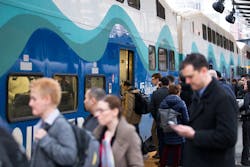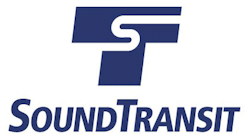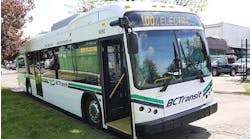Technology continues to be a strong factor; transit has the unique opportunity to utilize it to both increase and monitor ridership. With all the emerging modes of transport, how can agencies stay ahead of the curve and continue to provide services for both current riders and attract new ones?
Managing Back-End Data
One of the aspects of ensuring that an agencies ridership can increase is keeping the system on track. Avail provides its customers with data that is displayed in an easy-to-view format; including graphs.
“In Avail DataPoint we have the ability to see beyond just fare box data, but see CAD/ADL data so customers could look at schedule adherence and routing time. Today our big focus is on true business intelligence, this was really part a two prong when it comes to data, we integrated the Fleet-Net product into the Avail family, which is an ERP designed for public transportation. That gives us a much bigger data set,” explained Ryan Harshbarger Avail business intelligence and Fleet-Net specialist. “Fleet-Net has modules that are focused on asset management, vehicle maintenance, the entire way through to human resources and a fully featured finance back. With all of this data coming into the Avail ecosystem we had to get a robust business intelligence solution to source the data and put it into a format that agencies can use.”
Avail offers their customers a service team that offers agencies the ability to do in-depth analyses of their systems.
“While there definitely is a ridership decline across the industry, we can look at bright spots. BRT has been seeing success where other segments are dropping off. There are also quite a few systems that have undertaken overalls sometimes part of BRT or light rail expansion and some of that comes with just the realignment of bus routes,” said Harshbarger. “One of the things that you have to take into account when you’re doing this kind of overhaul is the underlying data. Is BRT successful because you get better on-time performance and a dedicated lane? Is it successful because of the high rate of frequency? The data really helps measure that, there are lessons learned that you can take over to traditional fixed route.”
Harshbarger explained that agencies use predictive technology more often than meets the eye.
“Predictive technology has been used in estimating real-time departures for some time… If you want to keep your ridership and potentially grow your ridership you need to provide adherence to public schedules. Using data to continue to tweak your schedule, getting your on-time performance, making sure that buses are where they’re supposed to be when they’re advertised to be there. I think that is really the first leg of what can be done with the data that we’re warehousing, and how to predict the location of buses so customers can have a high degree of confidence in their system,” said Harshbarger.
Harshbarger added that he feels one misconception of the furthered use of data is that it is a change in philosophy for the industry. “In our industry we’ve always been data driven, it is just we have the ability to capture much greater data it’s really like a change in mythology.”
Transit planners have worked with data constantly with data to determine ridership numbers, popular stops and any changes.
“The difference today is that we’re collecting that on everything in virtually real-time. The real change is embracing that big data set and realizing that many of those things we did as an industry in transit, we’re still doing it, and we are just doing it with tens of thousands of samples compared to hundreds for a week,” said Harshbarger. “As you build out and use an integrated transportation system, like what we offer at Avail, you might look and see late departures and through measuring the performance of your maintenance department find out that the miles between road-goals have dropped. So the late performance is really less about the schedule and more about the reliability in the fleet. Or the human resource system might tell you that late because you’re having to fill absentee positions at the last minute. That complete picture really provides the systems the ability to understand the overall system and ensure that it is reliable for the customer.”
Utilization of Social Media
Once ridership levels have increased, there is a need to maintain those numbers. One technology driven aspect of that process is the utilization of social media to monitor data on how many riders are interacting with the agency. Sound Transit, which has reached a strong level of ridership – including reaching capacity on many of the agencies bus routes and commuter, light rail lines.
“When you look at (social media) as a tool, that’s where our riders are. We see these huge ridership increases on light rail and we’ve also seen our following double. Our followers on social have kind of mimicked our big increases in ridership. They track together,” explained Bruce Gray, online engagement program manager for Sound Transit. “That’s where our riders are so that’s where we need to get information out to them about what is happening day-to-day and hour-to-hour on light rail especially. It just makes sense to be there where your riders are.”
Sound Transit launched a number of different campaigns that were focused on topics that made rider experiences smoother, increased ridership on underperforming routes and targeted specific age groups. The Rider Care effort educated riders on making travel easier to ride – from keeping bags off seats and informing riders who were ‘manspreading’ to make room for other customers to sit down.
“Outside of that rider care effort we had a few targeted campaigns, where we’re trying to drive awareness about a couple of different routes that were under preforming and also to help promote a special rider campaign,” said Gray. “Last summer we had a rider campaign that we internally called the Teen Freedom campaign where Sound Transit was offering discounted trips for anyone under 18 using their ORCA Youth Card. Riders who were under 18 you could use their ORCA card to get to Seattle for a $1.50. We also offered discounted light rail rides with their ORCA Youth Card. We did a lot of targeted marketing through Instagram and Facebook and Twitter to get the word out about this new option – that if you’re a kid who is out of school for the summer and here is a really cheap way to get around or get into the city from some of the outlying suburbs.”
Sound Transit experienced a rise in youth ridership. “It was a new program that Sound Transit and Metro were offering to try to boost youth ridership and to encourage kids to take transit. That seemed like an obvious fit, which is an audience that is there on social media, especially Instagram and we had some resources and tools to target our messages about taking the train to those audiences. Within Facebook and Instagram you can target your audience by age, location and zip code,” said Gray.
Sound Transit targeted age groups 18 and under for their special fares. The targeted Instagram and Facebook ads also appeared within a couple of miles of the stations where the programs were running.
“We saw a decent engagement on Instagram with our Teen Freedom campaign it wasn’t going viral, but at the same time we saw big ridership increases for those youth riders on our light rail and Sounder trains,” Gray added. “By riders using their ORCA Youth Pass we can go back and look at those numbers and really track that we had success of increasing ridership on those routes.”
Sound Transit also was able to utilize social media to grow areas that the agency was not experiencing the same levels of ridership as other lines.
“We had a couple under preforming bus routes and our service planners identified those as a place that we could use some help to try and drive ridership,” Gray said.





